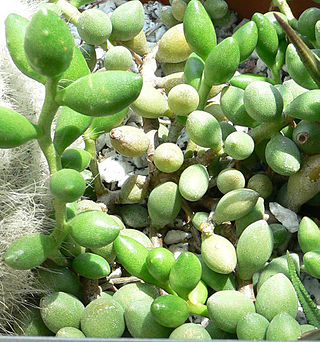
KalanchoeKAL-ən-KOH-ee, also written Kalanchöe or Kalanchoë, is a genus of about 125 species of tropical, succulent plants in the stonecrop family Crassulaceae, mainly native to Madagascar and tropical Africa. A Kalanchoe species was one of the first plants to be sent into space, sent on a resupply to the Soviet Salyut 1 space station in 1979. The majority of kalanchoes require around 6-8 hours of sunlight a day; a few cannot tolerate this, and survive with bright, indirect sunlight to bright shade.

Aeonium, the tree houseleeks, is a genus of about 35 species of succulent, subtropical plants of the family Crassulaceae. Many species are popular in horticulture. The genus name comes from the ancient Greek αἰώνιος / aiōnios (ageless). While most of them are native to the Canary Islands, some are found in Madeira, Cape Verde, Morocco, in East Africa and Yemen.

Dudleya virens, the green liveforever or bright green dudleya, is an uncommon species of perennial, succulent plant in the family Crassulaceae, native to several coastal southern California and Baja California locations.
Antonina Georgievna Borissova (1903–1970) was a Soviet botanist, specialising in the flora of the deserts and semi-desert of central Asia. Borissova authored 195 land plant species names, the ninth-highest number of such names authored by any female scientist.

Dudleya, commonly known as liveforevers is a genus of rosette-forming succulent plants in the stonecrop family, Crassulaceae, consisting of about 68 taxa in southwestern North America and Guadalupe Island. The species come in many forms, with some large and evergreen, others geophytic and deciduous. Yet, despite their dramatic variations in appearance, most species readily hybridize. The flowers of Dudleya have parts numbered in fives, with the petals arranged in tubular, star-shaped, and bell-shaped forms and, when fruiting, are filled with tiny, ovoid-crescent-shaped seeds.

Adromischus is a genus of flowering plants. They are easily-propagated, leaf succulents from the family Crassulaceae, which are endemic to southern Africa. The name comes from the ancient Greek adros (=thick) and mischos (=stem).

Hylotelephium is a genus of flowering plants in the stonecrop family Crassulaceae. It includes about 33 species distributed in Asia, Europe, and North America.

In botany, succulent plants, also known as succulents, are plants with parts that are thickened, fleshy, and engorged, usually to retain water in arid climates or soil conditions. The word succulent comes from the Latin word sucus, meaning "juice" or "sap".

Cotyledon tomentosa is a species of flowering plant in the family Crassulaceae, native to South Africa. It is a succulent evergreen shrub with large chunky ovate fuzzy green leaves. Its autonymous subspecies is known as the bear's paw because of the prominent "teeth" at the tips of its leaves. It forms large orange bell-shaped flowers in spring. In its native habitat, the Little Karoo region of South Africa, Cotyledons usually grow in rocky quartz fields where they have excellent drainage provided by very porous soil.

Aeonium leucoblepharum is a succulent flowering plant in the family Crassulaceae. The pointed leaves have a strong central stripe, and they may develops pinkish colour on exposure to strong sunlight. There are variants with less pointed leaves but still with the central stripe. The flowers are yellow, 7- to 10-merous, with petals 6 – 8 x 1.8 – 2.5 mm. The species is native to mountains in Yemen and north-eastern Africa, from Ethiopia and Somalia to Kenya and Uganda. It is also known as Sempervivum leucoblepharum and Sempervivum chrysanthum.

Kalanchoe rhombopilosa is a succulent plant species in the family Crassulaceae. This species of plant is endemic to southwest Itampolo, Madagascar. The species was described by Mannoni & Boiteau in 1947 and is indexed in Notul. Syst. (Paris) 13:153-154, (1947). The plant is a herbaceous perennial that grows to 10–20 cm in height.

Hylotelephium erythrostictum, commonly known as garden stonecrop, is a herbaceous perennial plant in the genus Hylotelephium, belonging to the family Crassulaceae.

Reid Venable Moran was an American botanist and the curator of botany at the San Diego Natural History Museum from 1957 to 1982.

Echeveria runyonii is a species of flowering plant in the family Crassulaceae, that is native to the state of Tamaulipas in Mexico. Several cultivars have been described and cultivated.

Orostachys is a genus of the succulent family Crassulaceae that contains about 15 species. It is a biennial herb growing in China, Japan, Kazakhstan, Korea, Mongolia, Russia. Eight species occur in China.
Heidrun Hartmann, née Heidrun Elsbeth Klara Osterwald was a German botanist.

Sedum adolphi, the coppertone stonecrop or golden Sedum, is a species of succulent plant in the family Crassulaceae. It is native to Mexico, where it grows in rocky terrain and on cliff faces. It has also become naturalized in Sicily and the Canary Islands. It is known for its bright orange-copper leaves and white flowers that bloom in the spring.

Sedum sarmentosum, known as stringy stonecrop, gold moss stonecrop, and graveyard moss, is a perennial flowering plant in the family Crassulaceae native to East Asia and Southeast Asia (Thailand). It has been introduced in at least eastern North America, and Europe.

Sempervivoideae is the largest of three subfamilies in the Saxifragales family Crassulaceae, with about 20–30 genera with succulent leaves. Unlike the two smaller subfamilies, it is distributed in temperate climates. The largest genus in this subfamily is Sedum, with about 470 species.

Dudleya pachyphytum is an insular succulent plant known by the common name Cedros Island liveforever. It is a member of the genus Dudleya, in the family Crassulaceae. Characterized by thick, blunt leaves covered in a white, powdery wax and adorned by white flowers in bloom, it is regarded as one of the most attractive and charismatic members of its genus. It is endemic to the foggy northern end of Mexico's Cedros Island, occupying an ecological niche shared with the Cedros Island Pine.

















